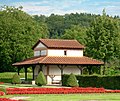Gallo-Roman common temple

Gallo-Roman common temple is the modern name of a specific type of temple that was found mainly in the Gallic , Germanic and British provinces of the Roman Empire. These are the regions that were previously largely shaped by the Celtic culture. Possibly the cult practices in these religions required this special design.
From the first half of the 1st century, only a few Gallo-Roman temple temples are known. Most of the sanctuaries of this type of construction are dated to the second half of the 1st century and the 2nd century. Since the middle of the 3rd century the construction of such temples has steadily decreased.
This type of temple usually consists of only one room ( cella ) with a door. A corridor runs around this space. Because of the poor preservation of many temples, the reconstruction of the handling is not always guaranteed. In many cases, rows of columns are assumed, in individual cases it could also be a closed corridor. According to archaeological finds in the Abbey of Saint-Georges-de-Boscherville , a Gallo-Roman stone temple with handling could follow a similar Gallic wooden temple.
As in other cultural areas, there was a blending of indigenous and Mediterranean elements in temple architecture. The gallery and the cella were covered with roof tiles based on Mediterranean models. The rows of columns that surround the cella can also be traced back to Mediterranean influences.
The cella was probably higher than the gangway. The temples are relatively small with a side length of 15 to 20 meters. They are mostly built of stone, although there are also examples made of wood. The origin of the Celtic Viereckschanzen is presumed, not least because in some places, for example in Gournay-sur-Aronde , Gallo-Roman ramparts were successors to Viereckschanzen.
Mainly Celtic deities were worshiped in the common temples, but only a few are known. Sometimes locations of Gallo-Roman common temples can be recognized by an epithet in the place name, as at Oisseau-le-Petit ( Département Sarthe ), where there was a Fanum . In the 9th century the place was mentioned in a document as Oxellum . Oxellum is derived from the Celtic word uksello- , "the high one", and indicates a deity and thus the location of a temple.
Replica in the Roman Museum Schwarzenacker
Reconstructed Gallo-Roman temple on the Martberg / Eifel
literature
- Michael Altjohann: Comments on the origin of the Gallo-Roman temple. In: Wolfgang Czysz , Claus-Michael Hüssen , Hans-Peter Kuhnen , C. Sebastian Sommer , Gerhard Weber (Hrsg.): Provinzialrömische Forschungen. Festschrift for Günter Ulbert on his 65th birthday. Leidorf, Espelkamp 1995, ISBN 3-89646-000-5 , pp. 169-203.
- Michael Altjohann: Gallo-Roman temple temples and buildings in Viereckschanzen. In: Günther Wieland (Ed.): Keltische Viereckschanzen. On the trail of a riddle. Theiss, Stuttgart 1999, ISBN 3-8062-1387-9 , pp. 105-112.
- William van Andringa (ed.): Archeology des sanctuaires en Gaule romaine (= Center Jean Palerne. Mémoires. 22). Publications de l'Université de Saint-Etienne, Saint-Etienne 2000, ISBN 2-86272-202-2 .
- Jean-Louis Brunaux: The Celtic Sanctuaries of Northern France. In: Alfred Haffner (ed.): Sanctuaries and sacrificial cults of the Celts (= Archeology in Germany . Special issue 1995). Theiss, Stuttgart 1995, ISBN 3-8062-1147-7 , pp. 55-74.
- Isabelle Fauduet: Les temples de tradition celtique en Gaule romaine. Éditions Errance, Paris 1993, ISBN 2-877-72074-8 .
- Thomas Lobüscher: Temple and theater building in the Tres Galliae and the Germanic provinces. Selected aspects (= Cologne studies on the archeology of the Roman provinces . Volume 6). Leidorf, Rahden 2002, ISBN 3-89646-134-6 (also: Cologne, University, dissertation, 1999).
- Friedrich Schlette : Celts between Alesia and Pergamon. A cultural history of the Celts. Urania, Leipzig et al. 1976.
- Heinz Hermann Steenken: handling stamp. In: Reallexikon der Germanischen Altertumskunde (RGA). 2nd Edition. Volume 31, Walter de Gruyter, Berlin / New York 2006, ISBN 3-11-018386-2 , pp. 422-429.
Web links
- Celto-Roman Temples in the United Kingdom (English)
- Reconstruction of a Gallo-Roman temple
- Le temple de Janus à Autun, visite 3D (3D tour of the Janus temple of Autun, France)
Individual evidence
- ↑ Thomas Lobüscher: Temple. In: Thomas Fischer (Ed.): The Roman Provinces. An introduction to their archeology. Theiss, Stuttgart 2001, ISBN 3-8062-1591-X , pp. 77-79, here p. 78.
- ↑ Stefanie Martin-Kilcher, Daniel Castella: Faith, Cult and Graves. In: Switzerland from the Paleolithic to the Early Middle Ages. Volume 5: Laurent Flutsch, Urs Niffeler, Frédéric Rossi (eds.): Roman times. Verlag Swiss Society for Prehistory and Early History, Basel 2005, ISBN 3-908006-56-2 , pp. 305–355, here p. 315.
- ^ Ernest Nègre : Toponymie générale de la France . Volume 1: Formations préceltiques, celtiques, romanes (= Publications romanes et françaises. 193). Librairie Droz, Geneva 1990, p. 162 .
- ^ François de Beaurepaire: Les noms des communes et anciennes paroisses de la Seine-Maritime . A. et J. Picard, Paris 1979, ISBN 2-7084-0040-1 , pp. 119 .
Remarks
- ↑ In France, Gallo-Roman temples are called fanum .




